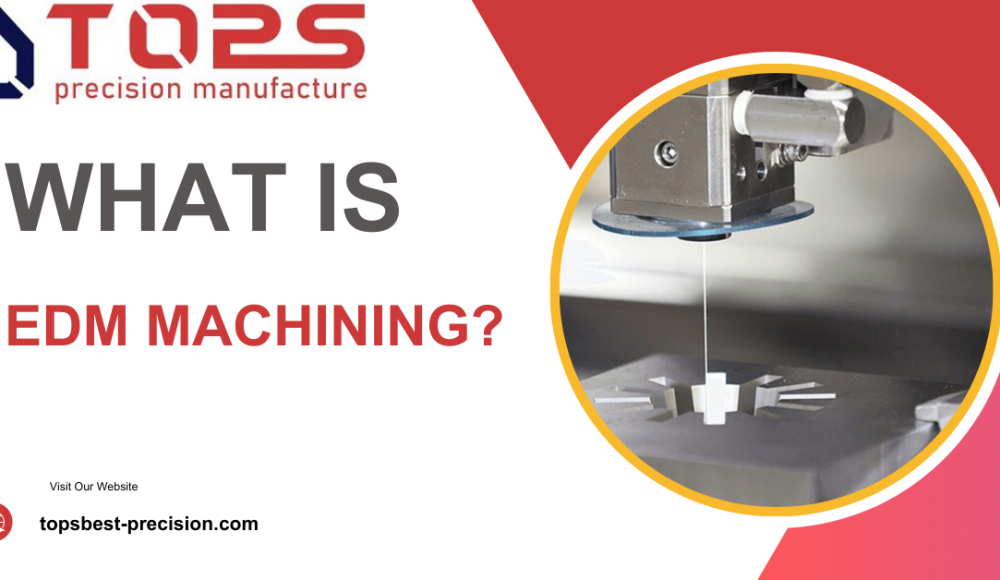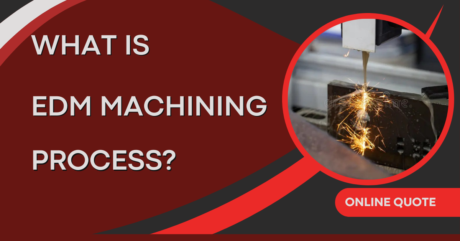Have you ever thought of designing something on a diamond with traditional tools? What will happen? Milling machines would struggle or damage the workpiece. So what is the solution? Electrical discharge machining (EDM) is an advanced process that erodes material from a workpiece. Due to controlled electrical sparks, the precision is exceptional. This tolerance is very difficult to meet with traditional CNC machines.
Interesting Facts: EDM tolerance can be much tighter than 300 microns.
Interestingly, scientists are researching to enhance EDM efficiency. For instance, metal-ceramic composite electrodes provide good conductivity and wear resistance.
Let’s explore another example so if you are a beginner, then you can grasp the idea. Just imagine a tiny but precise lightning strikes the object repeatedly to get the complex shape on conductive materials such as:
- Steel
- Titanium
- Exotic alloys
What is Electrical Discharge Machining?
EDM is machine. Its abbreviation is electrical discharge machining. CNC machinists incorporate this technology to cut parts with one ten-thousandth of an inch accuracy. That is equivalent to taking a human hair and cutting it into 40 pieces—crazy tight tolerances. This is easily one of the most precise machines in the shop. Now, this technology has been around since the 1940s. It’s used primarily in the aerospace, medical, and tool and die industries.
Traditional Machining vs. EDM (Machining)
Although 3-axis or 5-axis CNC machining methods are good, they can’t develop accurate designs compared to EDM machining. Drilling, milling, or turning—all these machines use sharp tools to design a material. Yet, all these modern tools do not guarantee zero tolerance.
Limitations of Traditional Machining
- Limited Capabilities:Traditional machining often fails to make objects with thin walls. The point is that the cutting tool already has a size that can’t reach the corners.
- Material Restrictions:Tough materials can damage cutting tools quickly.
- Heat Generation:Traditional machining generates friction heat. This heat can damage delicate objects.
Types of Electrical Discharge Machining
There are two main types of electrical discharge machining.
- Electrical Discharge Machining
- Wire electrical discharge machining
One is electrical discharge machining for stiff shoulders, and the other is wire electrical discharge machining. It’s all about the shape.
In electrical discharge machining, the shape of the electrode is determined to be the product’s shape. Similarly, as the electrical discharge machining is repeated, the product gradually falls in love with the shape of the electrode. Wire electrical discharge machining uses wire. The product is cut. It is also called wire cutting.
Advantages of Electrical Discharge Machining
EDM overcomes the following limitations:
Complex Shapes:
EDM is capable of making 2D or even 3D designs with high precision. One of the amazing parts of EDM machining is that it handles the most complex designs.
Hard Material Machining:
EDM incorporates electrical sparks. It means that machining centers are now capable of machining most rigid materials.
Minimal Heat Affected Zone (HAZ):
The heat in electric discharge machining is very controlled. Therefore, the heat doesn’t damage the workpiece.
Disadvantages of Electrical Discharge Machining
- Limited to Conductive Materials
- Slow Material Removal Rate
- Electrode Wear and Tear
- Surface Integrity Issues
- Difficulty Machining Sharp Corners and Small Features
- Environmental Concerns
Applications of EDM (uses of EDM)
EDM tolerance makes it prominent compared to other machining methods. Therefore, it has a range of applications:
Mold and Die Making:
Complex molds for injection molding and metal die casting require high precision and strength to handle hard tool steels. EDM excels in this situation.
Aerospace Parts:
Engine jets need light, heat-resistant light parts. Since they have complex shapes and traditional machining methods can’t meet specific demands, electrical discharge machining can develop highly accurate parts.
Medical Devices:
Surgical implants need higher precision and biocompatible materials. EDM machining effectively develops complex medical parts.
Electronics Industry:
Manufacturing tiny holes for wires on a printed circuit board is easy with EDM CNC machining.
What Surface Finishing EDM Can Achieve?
| Factor | Impact on Surface Finish | Resulting Finish (Ra in Micro-Inches) |
| Discharge Energy | Higher energy = Rougher finish | 60 – 120 |
| Lower energy = Smoother finish | 15 – 30 | |
| Pulse Duration | Longer pulse duration = Rougher finish | 60 – 120 |
| Shorter pulse duration = Smoother finish | 15 – 30 | |
| Electrode Material | Brass and copper electrodes give smoother surface finishes | 20 – 40 |
| Dielectric Fluid | Dielectric type and flushing impact on surface finish | Depends on specific fluid and application |
| Workpiece Material | Harder materials tend to produce smoother finishes | 15 – 30 |
Understanding EDM Process Step By Step
Electrical discharge machining is a processing method that vaporizes things rather than cutting them. If you create a space between the positive and negative electrodes where no air current flows and then apply a huge voltage, a current will flow through the space.
This is a phenomenon of electric discharge. During this electric discharge, an extremely large amount of heat is generated, which causes the electrode to evaporate. This is used in electrical discharge machining. To put it simply, lightning is created artificially, and energy is generated. However, this discharge does not last forever.
After one discharge, there is a short break, and the object vaporizes. One discharge can range from a micron to several tens of microns. It’s a job that requires a lot of patience as it can only process about 300 degrees.
The Role of Electrodes (EDM Machine):
EDM uses two electrodes:
- One is the tool electrode, typically brass, copper, or graphite.
- The other is the object (workpiece itself).
Dielectric Fluid and Its Function:
Dielectric fluid, a non-conductive liquid, fills the space between the electrodes. This fluid has several purposes:
- Dielectric fluid insulates the space between the electrodes when not actively sparking.
- It helps cool the process and flush away debris.
The Spark Gap and Material Removal
Maintaining a small gap between the tool electrode and the workpiece is essential. When an electric current is applied, a high voltage builds up across this gap. This voltage eventually overcomes the insulating properties of the dielectric fluid, causing a spark to jump between the electrodes.
The intense heat (reaching temperatures of up to 12,000°C!) melts and vaporizes a tiny amount of material from both the electrode and the workpiece. This process keeps repeating itself, with thousands of sparks occurring per second. These sparks erode the material until you get the delicate shape.
Different Types of EDM Processes
There are three main types of EDM processes:
- Wire EDM
- Sinker EDM
- Hole Drilling EDM
Wire EDM Process Explained:
Imagine you have a moving wire in your hand. It is like cutting something. Similarly, a brass or tungsten wire passes through a submerged tank containing the workpiece. The wire itself doesn’t physically touch the workpiece.
The next step is going to be interesting. The moving wire and the workpiece generate sparks. It is important to note that it is not a simple wire-cutting method. The wire EDM process is exact. A wire-cutting machine erodes the material by following a path controlled by a CNC program.
To ensure a clean cut, machinists do not use these wires excessively. This practice ensures precise and clean cuts.
Advantages of Wire Cut EDM:
- Wire EDM excels at creating complex 2D shapes
- It can precisely make sharp corners and microscopic features.
- Wire EDM cuts thin sheets of metal precisely.
Applications of Wire EDM:
- Stencils and circuit board
- Aerospace
- Automotive industries for cutting complex shapes.
Sinker EDM (sinker edm machine)
In sinker EDM, the tool electrode follows a given geometric shape. It replicates the desired feature on the workpiece. Unlike wire EDM, the tool electrode sinks vertically into the dielectric fluid towards the workpiece. Machinists must control the gap between the electrode and the workpiece.
As the tool electrode slowly moves down, following a CNC program, sinker EDM erodes the workpiece material. It replicates its shape in a three-dimensional way, which can create complex cavities and pockets.
Advantages of Sinker EDM:
- Sinker EDM can make complex 3D shapes
- Best for complex designs, molds, and cavities
Applications of Sinker EDM:
- Sinker EDM is widely used in mold and die-making
- Aerospace and medical device industries.
Hole Drilling EDM
Hole drilling EDM is a particular type of Electrical Discharge Machining where electrical sparkles are used to make accurate holes in conductive materials. The dielectric fluid is continuously flushed to cool and remove debris as sparks erode material from the workpiece along the hollow electrode shape. This approach provides excellent accuracy for tiny holes, is suitable for difficult-to-machine materials, produces fine surfaces but it can be slow and call for electrode wear control and surface layer reconditioning.
CNC Integration and Automation in EDM
Modern EDM CNC machines come with CNC technology. It works as the brain of the operation. For example, it can effectively translate digital design. This integration offers numerous benefits:
Advantages of CNC in EDM
- Improved Accuracy
- Complex Machining Capabilities
- Increased Productivity and Efficiency
Automation in EDM Processes
Other than CNC machines, some automation features further enhance EDM efficiency. For example:
- Automatic Wire Threading:In wire EDM, automated systems can thread the thin wire through the machine.
- Adaptive Control Systems:These advanced systems can monitor the machining process in real-.
- Automated Workpiece Handling:Automated systems can load and unload workpieces from the machine for high-volume production runs.
What Types of Materials Can be Processed with EDM?
- Metals: Steels, aluminum, copper, titanium, alloys, etc.
- Graphite (used for electrodes in EDM itself)
Sample EDM Process Comparison for Different Materials
Conductivity is one of the critical factors in processing materials with EDM machining. Certain materials are very difficult, such as:
- Steel
- Aluminum
- Brass and even exotic alloys.
Subsequently, heat resistance is the 2ndmajor factor in electric discharge machining. Since EDM generates extremely heated sparks, we need materials that can withstand the extreme pressure.
Below, you will find precise information on the EDM process using different materials.
| Material | Melting Point (°C) | Typical Spark Parameters | Machining Time (compared to Traditional) | Material Waste | Approximate Cost (compared to Traditional) |
| Steel (AISI 1018) | 1482 | Lower voltage, shorter pulse | Slower | Lower | Higher |
| Aluminum (6061) | 660 | Lower voltage, shorter pulse | Slower | Lower | Higher |
| Brass (C360) | 900 | Moderate voltage, moderate pulse | Similar | Lower | Similar |
| Titanium (Grade 2) | 1668 | Higher voltage, longer pulse | Slower | Lower | Higher |
Note: For the cost and further details, you should contact a professional CNC machining shop.
When to use EDM?
We can use EDM in the following situations:
- Hard or Brittle Materials
- Tiny Holes and complex Features
- Minimizing Heat Distortion
- Burr-Free Finishes
Conclusion
Electric Discharge Machining (EDM) is gaining popularity in the manufacturing industry. It is the perfect alternative to traditional machining methods and can efficiently execute designs on the most rigid conductive materials.
- What Electrical Discharge Machining is Good At?
Machining electrical discharge machining is good at
- Fine detail
- Machining tough metals
2. What Electrical Discharge Machining is Not Good At?
Machining that electrical discharge machining is terrible at:
- Mass production
- Making it smooth, like polishing
3. What is the Principle of EDM?
EDM carries controlled corrosion. Here are the key steps:
- Electrodes
- Dielectric Fluid
- Spark Generation
- Material Removal
- Precise Control







2 thoughts on “What is Electrical Discharge Machining? Ultimate EDM Guide 2024”